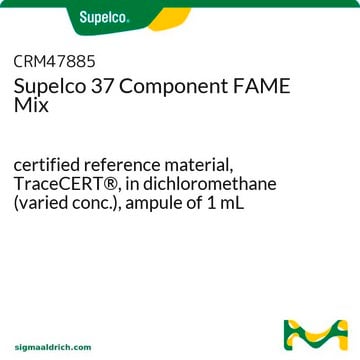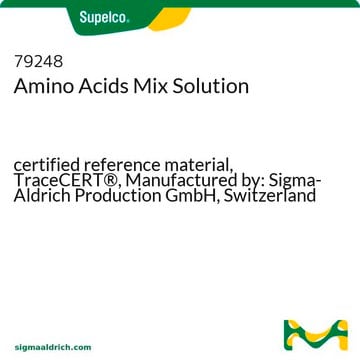89683
Toluène
suitable for HPLC, ≥99.7% (GC)
About This Item
Produits recommandés
Qualité
HPLC grade
Niveau de qualité
Densité de vapeur
3.2 (vs air)
Pression de vapeur
22 mmHg ( 20 °C)
26 mmHg ( 25 °C)
Essai
≥99.7% (GC)
Forme
liquid
Température d'inflammation spontanée
997 °F
Durée de conservation
limited shelf life, expiry date on the label
Limite d'explosivité
7 %
Technique(s)
HPLC: suitable
Impuretés
≤0.05% water
Résidus d'évap.
≤0.001%
Indice de réfraction
n/D 1.496 (lit.)
n20/D 1.497
pb
110-111 °C (lit.)
Pf
-93 °C (lit.)
Densité
0.865 g/mL at 25 °C (lit.)
Force du solvant ε (Al2O3)
0.29
λ
1 cm path, H2O reference
Absorption UV
λ: 285 nm Amax: 1.0
λ: 310 nm Amax: 0.1
λ: 350 nm Amax: 0.01
Chaîne SMILES
Cc1ccccc1
InChI
1S/C7H8/c1-7-5-3-2-4-6-7/h2-6H,1H3
Clé InChI
YXFVVABEGXRONW-UHFFFAOYSA-N
Vous recherchez des produits similaires ? Visite Guide de comparaison des produits
Mention d'avertissement
Danger
Mentions de danger
Conseils de prudence
Classification des risques
Aquatic Chronic 3 - Asp. Tox. 1 - Flam. Liq. 2 - Repr. 2 - Skin Irrit. 2 - STOT RE 2 Inhalation - STOT SE 3
Organes cibles
Central nervous system
Code de la classe de stockage
3 - Flammable liquids
Classe de danger pour l'eau (WGK)
WGK 3
Point d'éclair (°F)
39.9 °F - closed cup
Point d'éclair (°C)
4.4 °C - closed cup
Équipement de protection individuelle
Eyeshields, Faceshields, Gloves, type ABEK (EN14387) respirator filter
Faites votre choix parmi les versions les plus récentes :
Certificats d'analyse (COA)
It looks like we've run into a problem, but you can still download Certificates of Analysis from our Documents section.
Si vous avez besoin d'assistance, veuillez contacter Service Clients
Déjà en possession de ce produit ?
Retrouvez la documentation relative aux produits que vous avez récemment achetés dans la Bibliothèque de documents.
Active Filters
Notre équipe de scientifiques dispose d'une expérience dans tous les secteurs de la recherche, notamment en sciences de la vie, science des matériaux, synthèse chimique, chromatographie, analyse et dans de nombreux autres domaines..
Contacter notre Service technique









